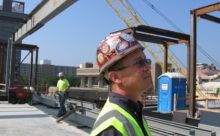The Cultural Traditions of Ironworkers
By James P. Leary
The International Association of Bridge, Structural, Ornamental and Reinforcing Ironworkers formed in 1896. Rooted in the ancient trades of carpentry and masonry once essential to bridge and building construction, as well as to the medieval guilds of wrought-iron craftsmen, the IABSO&RIW emerged amidst the rise of metal bridge and building construction, as well as in an era marked by fierce struggles of workers for the right to organize. Popularly known and self-described as “ironworkers,” even though their work is done chiefly with steel, members of the ironworkers union in the 21st century erect the frames of large buildings and bridges, position rebar for reinforced concrete, manipulate and install stair railings, fashion ornamental metalwork, move heavy equipment, and a good deal more. Following upon an extended and rigorous apprenticeship program, journeyman ironworkers must be competent at positioning and connecting steel beams, “rodbusting” or tying rebar, and welding. Thanks to relative accord with contractors nowadays, strikes are rare, good pay and pensions are the norm, and safety is paramount on job sites. At the same time, work is seldom steady since new construction rises and falls with the prevailing economy; technology changes constantly; and workforce demographics alter as African Americans, new immigrants, and some women enter the trade alongside the traditional male American Indian and European American ironworkers.
Possessing individual and collective occupational and organizational histories, ironworkers also recall and practice an array of distinctive cultural traditions. Retired ironworkers and many still active have vivid memories of debates over whether money for pensions or beer was more important, of walking picket lines, of “booming out” to pay their “dobies” (fees) to another local that had work, of eating midday meals packed in uninsulated metal lunch pails, of “riding the load” of I-beams or the “headache ball” on a crane’s cable to a skeletal building’s upper reaches, of walking “on high steel” while not “tied off,” of working bare-handed and bare-headed in the pre-glove and hard hat era, of hand-splicing frayed wire rope, and good deal more. Such rich laborlore also includes distinctive tools, clothing, gestures, speech, stories, pranks, informal competitions, customs like the “topping out” ceremony for completion of a building’s frame, and a widespread self-image as--in the words of Norm Brown, a veteran ironworker--“the fightin’est group of the trades” or, as an envious cement finisher put it, “the Marines of the building trades.” Adept at the art of working, more than a few ironworkers are also accomplished artists who make or alter occupational gear and tools, while using welding skills, scrap rebar, and tie-wire off-the-job to fashion a range of practical and playful objects.
The culture of ironworkers historically has attracted attention from writers and scholars including folklorists. In 1892, philosopher William James was dazzled when: “The sight of a workman doing something on the dizzy edge of a sky-scaling iron construction brought me to my senses very suddenly . . . Heroism . . . was before me in the daily lives of the laboring classes.” In 1949, journalist Joseph Mitchell’s “Mohawks in High Steel” chronicled American Indian ironworkers in New York City and farther afield (New Yorker, September 17). Mike Cherry’s powerful memoir, On High Steel: The Education of an Ironworker, appeared in 1974. In the 1970s ironworkers were prominent participants in the Smithsonian Institution’s Festival of American Folklife, culminating in two weeks devoted to “Workers Who Build” amidst the summer-long bicentennial FAF. And there are frequent references to ironworkers throughout the writings of Archie Green, including this passage from Working Americans: Contemporary Approaches to Occupational Folklife (1978) that emphasizes the literally and figuratively foundational nature of the trade: “The ironworker’s skill establishes the physical site where white collar lore emerges.”
